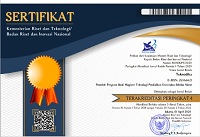The Implementation of Blended Learning Using Google Application in Mathematics Learning in the Pandemic Period
Abstract
Keywords
Full Text:
PDFReferences
Asfar, N., & Zainuddin, Z. (2016). Secondary students’ perceptions of information, communication, and technology (ICT) use in promoting self-directed learning in Malaysia. The Online Journal of Distance Education and E-Learning, 3(4), 67–82.
Husamah. (2014). PEMBELAJARAN BAURAN (BLENDED LEARNING) Terampil Memadukan Keunggulan Pembelajaran Face-To-Face, E-learning Offline-Online dan Mobile Learning. Jakarta: Prestasi Pustaka.
Sari, Milya. (2016). Blended Learning, Model Pembelajaran Abad Ke-21 Di Perguruan Tinggi.Ta'dib, Jurnal Fakultas Pendidikan dan Pelatihan Guru, Universitas Batusangkar, 17(2), 126-136. Dari http://ecampus.iainbatusangkar.ac.id/ojs/index.php/takdib/article/view/267/264.
Suharsimi Arikunto. (2013). Penelitian Tindakan Untuk Guru, Kepala Sekolah, dan Pengawas. Yogyakarta : Aditya Media.
Wena, Made. (2014). Strategi Pembelajaran Inovatif Kontemporer: Suatu Tinjauan Konseptual Operasional. Jakarta: Bumi Aksara.
Zainuddin, Z. (2015). Exploring the Potential of Blended learning and Learning Management Systems (LMS) for Higher Education in Aceh. English Journal, 2(2),70–85.
Zainuddin, Z. (2017). First-Year College Students’ Experiences in the EFL Flipped Classroom: A Case Study in Indonesia. International Journal of Instruction, 10(1), 133–150.
Zainuddin, Z., & S. H. Halili. (2016). “Flipped Classroom Research and Trends from Different Fields of Study.”The International Review of Research in Open and Distributed Learning IRRODL, 17(3), 313–340.
Refbacks
- There are currently no refbacks.





.png)













